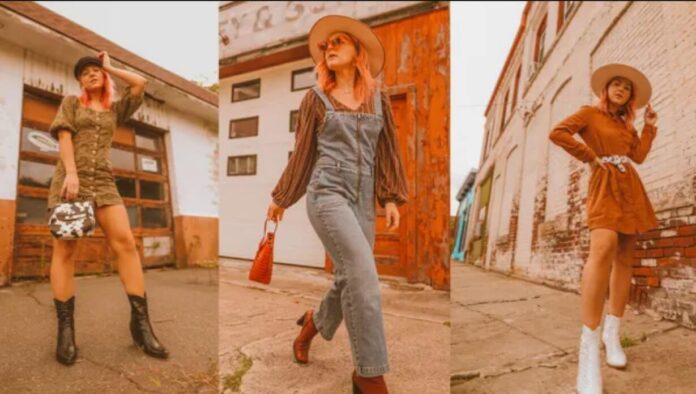The Western look, conjuring images of rugged cowboys, prairie dresses, and fringed jackets, holds a special allure in popular culture. But beyond the romanticized imagery lies a rich history filled with unexpected influences, surprising evolutions, and fascinating facts that challenge the stereotypes. Get ready to be amazed by 15 intriguing insights into the world of Western look:
1. Silver Spurs Weren’t Just for Show
Those jangling metallic ornaments weren’t merely fashion statements. Spurs served a practical purpose – urging horses forward and assisting with dismounting. The number of points on a spur often indicated the rider’s skill level, with fewer points for experienced cowboys and more for novices.
2. Bandanas Weren’t Just Protection
While bandanas shielded cowboys from dust and sweat, they also doubled as makeshift first-aid supplies, slings, and even handkerchiefs. Some cowboys even used them to signal each other with different colours and tying styles.
3. Denim Wasn’t Always Blue
Believe it or not, the iconic blue jeans worn by cowboys originated as brown canvas work pants made by Levi Strauss in the 1850s. Indigo dye became famous later thanks to its durability and colour fastness, especially against sweat and harsh weather.
4. Prairie Dresses Had Pockets
Contrary to the flowing, impractical image, many prairie dresses featured hidden or side pockets for practicality. These pockets held essential items like sewing needles, handkerchiefs, and even small tools, making them fashionable and functional for frontier life.
5. Hats Were More Than Style Statements
Beyond protecting cowboys from the scorching sun, hats also served as communication tools. Tilting the brim at certain angles could signal greetings, warnings, or romantic interest. The iconic Stetson hat, named after John B. Stetson, was initially designed for durability and comfort in all weather conditions.
6. Fringe Wasn’t Just Decorative
The fringed embellishments on jackets, shirts, and pants weren’t merely aesthetic. Fringe helped shed dust and rain, and the movement even distracted insects in the wild.
7. Native American Influences Run Deep
Contrary to popular misconceptions, Western fashion owes a significant debt to Native American attire. From moccasins and fringed jackets to intricate beadwork and geometric patterns, many elements were adopted and adapted from indigenous cultures.
8. The Western Look Went Hollywood
The silver screen played a significant role in shaping and romanticizing Western fashion. Movies like “High Noon” and “The Searchers” popularized specific clothing styles and accessories, influencing not just cowboys but everyday fashion trends.
9. Western Fashion Embraced Modernity
The Western look was active. It evolved, incorporating sportswear elements, punk aesthetics, and futuristic silhouettes. Modern designers like Ralph Lauren and Tom Ford often reimagine Western elements with contemporary twists.
10. Denim Became a Global Phenomenon
From its humble beginnings as workwear, denim, a key element of Western attire, transcended borders and became a global fashion staple. Today, jeans and denim jackets are worn across cultures and continents, a testament to the enduring appeal of the Western aesthetic.
11. Western Fashion Isn’t Just for Cowboys
The Western look has extended beyond its rural roots. From musicians and artists to street fashion and high-end designers, elements like cowboy boots, denim jackets, and even prairie-inspired dresses are being reinterpreted and worn by diverse individuals for various occasions.
12. Sustainability Goes West
Even the Wild West is embracing sustainability! Eco-conscious brands use recycled materials, organic cotton, and ethical production practices to create modern takes on Western attire, proving that style can be eco-friendly.
13. Western Fashion Has Political Power
Throughout history, the Western look has been adopted by various groups as a symbol of rebellion and social commentary. From punk rockers sporting cowboy boots to feminists reclaiming prairie dresses, Western attire has been used to challenge norms and make powerful statements.
Read Also: 4 Reasons Why One Should Wear Cotton Sarees in Summers
14. The Future of Western Fashion is Bright
Western fashion is far from outdated. With ongoing cultural influences, contemporary interpretations, and a growing eco-conscious movement, the future of the Western look promises to be both innovative and relevant for future generations.
15. It’s More Than Just Clothes
Ultimately, Western fashion is not just about clothing; it’s about cultural history, resilience, and a spirit of adventure. It’s a story of adaptation, evolution, and self-expression that inspires and influences even today.
So, there you have it – 15 fascinating facts that hopefully shed new light on the captivating world of Western fashion. Remember the rich history, surprising influences, and ongoing evolution the next time you see a cowboy hat, fringed jacket, or prairie dress.









